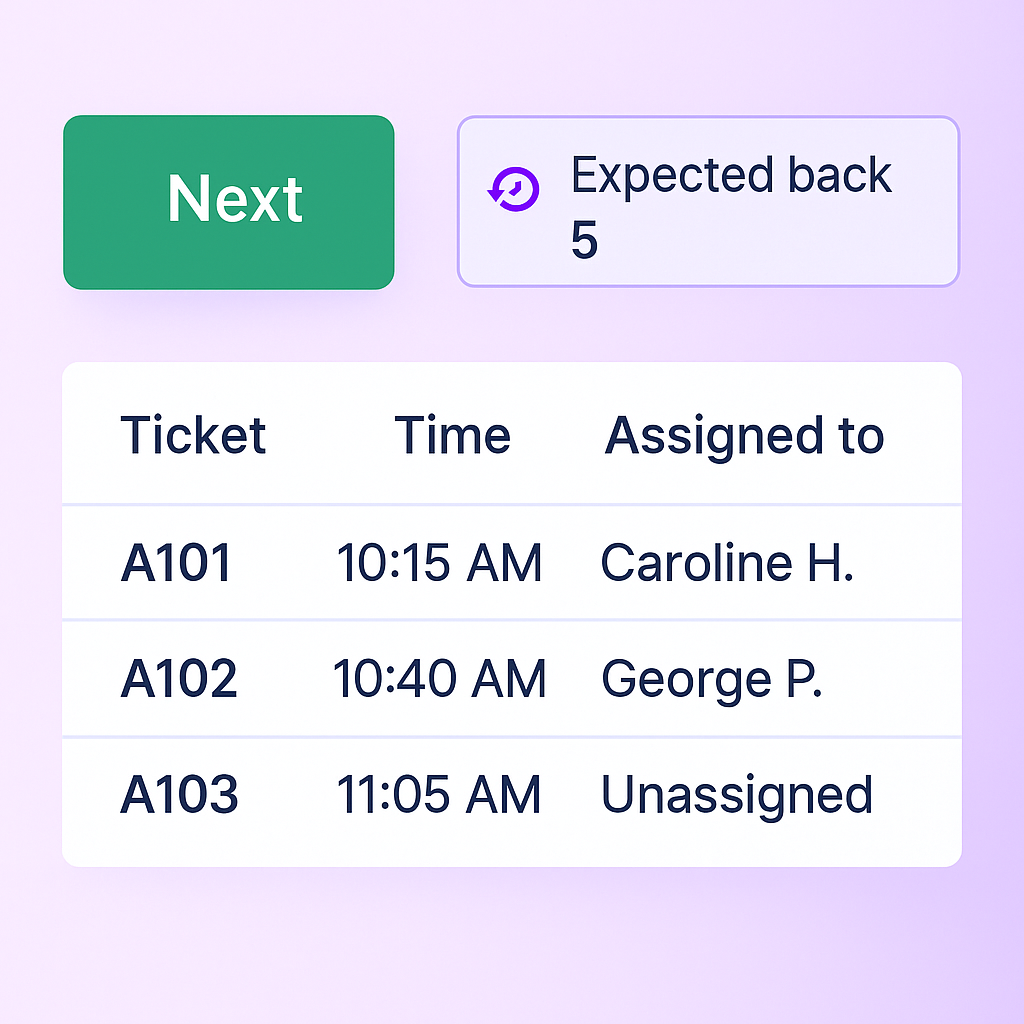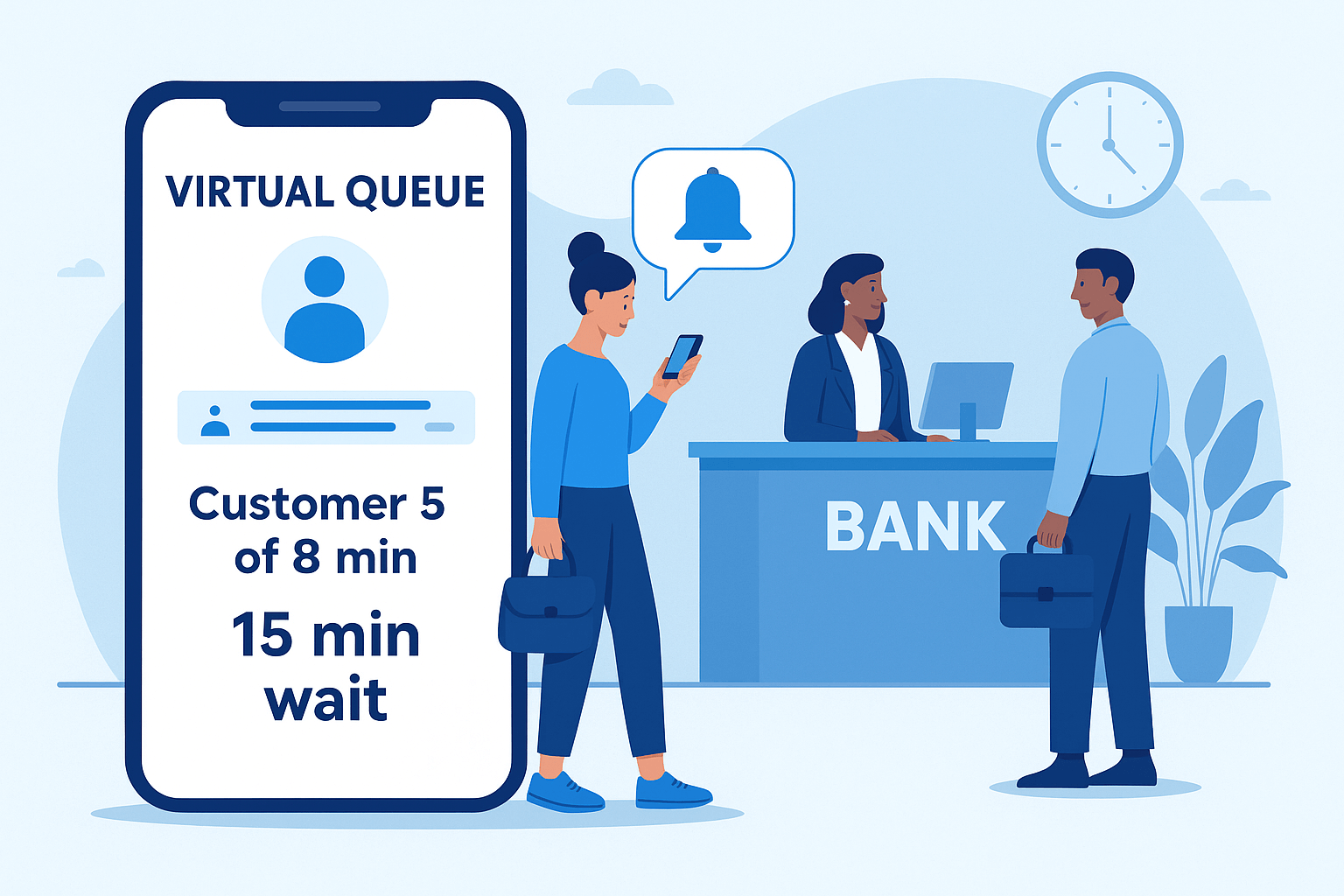What is queue management? In simple terms, it is the management of customers needing service from a business. Physical lines in a retail business indicate healthy demand, so long queues are a positive sign.
Customer Satisfaction (CSAT) scores fall the longer wait times increase. For example:
- Quick-service restaurants maintain a CSAT of 79, while full-service eateries slipped to 82 in recent years.
- Hotels have a CSAT score of 75, while banks maintain a score of 78 on average.
Modern businesses must shift their focus to customer experience and operational efficiency to maintain and improve CSAT scores. Defining queue management and integrating online and on-site solutions minimizes staff downtime and wait times, which is a good place to start.
What is Queue Management?
High customer volume is the “goal” for many businesses. Long lines equal higher demand and revenue. Sectors that fall into this category include:
Even government agencies require queue management systems that control customer flow across all physical and virtual environments.
In a restaurant, there are wait times for talking to the host or hostess and to be seated. Similar approaches are present when visiting healthcare facilities, waiting at the DMV, or hoping to speak to an advisor at the bank.
.png)
The Importance of Queue Management in Customer Experience
1. Enhancing Customer Satisfaction
Organization, short wait times and happy customers are the cornerstones of these systems. People want to feel like they are a priority and are willing to wait an “acceptable” amount of time, which varies from one industry to the next.
In the service industry, 88% of professionals state that customer expectations are higher than in the past.
To make customers happier, businesses must optimize resource allocation.
2. Streamlining Operations
Queues are overflowing for one of two reasons:
- Poor resource allocation
- Demand is too high (always a good thing)
Smoother operational flow, through this form of management, allows companies to optimize resources, improve staff efficiency and boost customer satisfaction.
Fast queues increase staff utilization rates, maximizing the profitability of each employee.

3. Improving Brand Loyalty
Queue management solutions also have a direct impact on long-term customer loyalty. Happy customers are:
- 5% more likely to stay with a business for every 1% increase in satisfaction
- 83% more likely to recommend your company
- 33% less likely to switch brands after a bad experience
Combining queue management into one main system will help businesses achieve all of these benefits and increase their return on investment (ROI).
Types of Queue Management Systems
Multiple types of queuing systems exist to meet the needs of customers physically and virtually.
.png)
📍 Physical Queue Management Systems
Customers, clients or patients walk into an office, receive a ticket and wait to hear their number being called. This is what a physical QMS is all about. Any form of managing queues within a physical location falls within this scope:
- Ticketing systems
- Sign-in sheets
Signing into a doctor’s or dentist’s office by going up to the rep or writing a name on a sign-in sheet indicates that the facility operates in a physical queuing environment.
📲 Virtual Queue Management Systems
A virtual management system is essential in today’s customer-centric business environment. Elements of these systems include:
- Mobile and web apps: Customers join a queue remotely on their mobile device, either through a mobile website or web app. Staff monitor these queues on a dashboard that connects directly to anyone in the queue.
- Kiosk-based Virtual Queuing: Customers can also join virtual queues at kiosks to monitor their place in line virtually.
A QMS offers a cohesive experience that connects both physical and virtual queues. Businesses monitor all of these queues through staff dashboards and optimization systems that reduce wait times.
Benefits of Queue Management Systems
Adopting an automated queue management system offers businesses, agencies and organizations strategic benefits, including:
Reduced Wait Times
Queue management systems prioritize and categorize customers based on their needs, allowing for more efficient routing to the appropriate staff member.
Additionally, teams are notified of the customer’s reason for service, which helps them prepare for the interaction and deliver a better experience.
Enhanced Operational Efficiency
A customer queue management system can greatly enhance operational efficiency by improving staff management and resource allocation.
Through data insights, automation and AI-powered features, bottlenecks are reduced and services are delivered more effectively.
Flexibility for Customers
Customer queue management empowers customers to wait wherever they want. Virtual queue systems deliver real-time notifications and reduce perceived wait times, so guests feel satisfied with their experience.
Better Data Insights
Data is power. Queue management systems collect and analyze key data that can be used to improve service quality, delivery efficiency and the customer experience.
Before vs. After Implementing a Queue Management System
Real-World Examples of Queue Management Systems
To put the benefits of a QMS into perspective, let’s look at some real-world examples of these solutions.
Retail Industry
A retail queue management system can help a busy electronics or telecom store serve customers more efficiently.
In a scenario like this, customers may be dropping in to buy new phones, get repairs or resolve billing issues.
A queue management solution will eliminate confusion and long wait times to ensure customers are served as quickly and effectively as possible.
Here’s how the system may work:
- A customer checks in at a digital kiosk or through a mobile app.
- They choose the reason for their visit (i.e., billing issue or phone repair).
- The customer is put into a virtual queue based on their selected service type and urgency.
- Staff are notified of the customer’s reason for their visit and assigned accordingly.
- The customer is notified when it’s their turn to be helped.
A system like this will reduce perceived wait times, optimize staff productivity and improve customer satisfaction.
Healthcare Sector
Having a waiting management system is crucial in the healthcare sector to ensure patient safety, reduce wait times and enhance patient care.
An urgent care facility, for example, may use a queuing system that:
- Allows patients to check in via a mobile app or kiosk.
- Uses an AI-based system to prioritize patients based on the severity of their condition
- Creates a dynamic and prioritized queue based on real-time data
- Updates displays in waiting areas or sends SMS to patients about their wait times
- Alerts staff of upcoming patient needs to ensure better prep and resource allocation
Advanced and optimized queue management systems allow healthcare facilities to deliver care faster and with greater precision.
Banking Industry
Bank branches can use queue management software to assist customers with account openings, loan consultations, issue resolution and more.
With a queue system in place, banks can:
- Allow customers to check in via an app or self-serve kiosk inside of the branch.
- Select their desired service.
- Categorize, prioritize and route customers based on their needs.
- Assign customers ticket numbers and update digital displays with real-time wait information.
- Empower branch managers to reallocate resources during peak times to serve customers more efficiently.
Along with reduced wait times, banks can improve their customer flow and staff productivity while gaining access to valuable data insights to make more informed decisions.
How to Choose the Best Queue Management System for Your Business
The benefits of a queue management system are clear, but what should be considered when evaluating solutions?
There are several things to keep in mind when comparing options, starting with the organization’s needs.
Assess Your Business Needs
Every business has its own unique needs. These should be defined in the early stages. What does the business specifically need to improve its queue management?
Consider:
- Industry
- Customer volume
- Service delivery style
A bank, for example, will likely have higher volume and more complex customer needs than a retail business. Healthcare facilities will have HIPAA concerns and other compliance regulations that will inform their decision.
Understanding the organization’s needs will help narrow down the options and allow leadership to compare solutions more effectively.
Evaluate Features
Once there is a greater understanding of the organization’s needs and goals, the next stage is to evaluate product features.
When comparing customer service queue management systems, consider critical features, such as:
- Mobile accessibility. Are client-facing features mobile-friendly? Today’s consumers expect to be able to check in, get queue time information and more right from their smartphones.
- Integration. Does the system integrate into your current tech stack? Easy integration with tools like Salesforce, Zoom, Teams, WhatsApp and other solutions will help simplify the adoption process and make it easier to implement into your workflow.
- Scalability. As the business grows and customer flow increases, will the solution scale with you? Look for systems with flexible frameworks and cloud-based features that can scale up or down as needed.
- Analytics and reporting tools. Does the solution offer reporting and tracking of key metrics that will help refine and improve queue management over time? The system should provide visibility on critical KPIs like customer wait times to meet internal goals.
The organization may also need other unique functions, so make evaluations consider all of the features required to reach internal goals.
Consider Cost
Finally, consider the cost of each solution. Evaluate pricing based on your internal budget and business size to ensure you’re making a smart investment.
Additionally, consider the return on your investment in terms of an improved customer experience and greater efficiency.
How to Implement a Queue Management System
Once a system has been chosen, implementation will be the next step. The goal at this stage is to ensure the entire team understands the benefits of the new system and is on board with adopting it.
Taking a strategic approach to implementation will make the entire process as smooth and stress-free as possible.
Define Objectives
Before initiating the implementation process, take a moment to define objectives.
What does the business want to achieve with a queue management system?
Do leaders want to:
- Reduce wait times?
- Boost customer satisfaction?
- Improve resource management?
Defining objectives helps businesses approach training and monitoring more intentionally.
Train Your Staff
Once the objectives for your digital queue management system have been clarified, the focus can shift to training staff on how to use it effectively.
Create a plan for the training stage and explore any training options that the company offers.
Monitor and Refine
Implementing an electronic queue management system is just the first step. Once the system is up and running, it’s important to monitor its performance and make adjustments based on data insights.
Consider asking customers to rate their experiences using your system and provide feedback that can be used to make improvements.
Adopting a culture of continuous improvement will help maximize the benefits of your system and continue to enhance the customer experience.
Conclusion: Why Queue Management is Essential for Modern Businesses
Whether running a retail store, bank or doctor’s office, delivering fast and efficient service is crucial.
In this post, we have answered the pressing question, “What is queue management?” Now, it’s time for you to discover the true benefits of implementing a system into your own business.
Take the time to weigh all of your options and choose a solution that aligns with your goals and needs.
A QMS can help organizations achieve this goal. From quicker service to greater personalization, the right solution helps teams resolve issues faster and complete services with greater efficiency.





.webp)

.jpg)







.svg)

